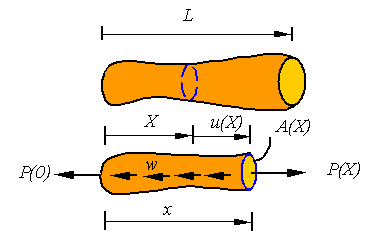Extension of bars
Uniform bars:
Consider the problem of calculating the extension ![]() due to the
application of an axial load P on a uniform bar as shown in the figure.
due to the
application of an axial load P on a uniform bar as shown in the figure.

A bar is considered uniform if its cross-sectional area
and elastic modulus are constant along the length of the bar. For such a bar
under axial loading, the stress and strain along the bar are constants and
given by the expressions

Assuming small strains and substituting these expressions
into Hooke’s law ![]() , one arrives at the equation for the extension of the bar
given as
, one arrives at the equation for the extension of the bar
given as
![]()
Non-uniform bars:
A bar with a varying cross-sectional area is an example of
non-uniform bar. In general, one can have varying cross section, elastic
modulus, and axial load in a bar. Such situations may result in varying stress
and strain along the bar. This, in turn, requires a more in depth analysis to
evaluate the extension of the bar. First, let us setup the kinematics of the
deformation. As shown in the figure, in a typical situation one would have an
initial unloaded configuration (top) and a configuration after loading
(bottom).

A typical cross-section that is at location X in
the initial configuration, ends up in location x in the current
configuration by being displaced a distance u from its original
location. Each cross section can be displaced a different amount and may have a
different cross-sectional area. Therefore, the displacement and cross-sectional
area are each a function of the location along the bar (i.e., u(X) and A(X)).
A typical segment of length ![]() of the bar is shown
in the following figure.
of the bar is shown
in the following figure.

The average strain in this segment of the bar is given by
the expression

One can take a limit as ![]() goes to zero to
define the strain at each point of the bar by
goes to zero to
define the strain at each point of the bar by
![]()
The extension of any segment of the bar is the difference
between the displacement of one end minus the displacement of the other end.
This expression for strain can be integrated to get the extension. Let us say
we are looking for the extension of the segment between X1
and X2. This would be given by integrating the strain to get

The total
extension ![]() of a bar of initial
length L is given by the expression
of a bar of initial
length L is given by the expression

As shown in the figure below, the bar might have a
distributed load w applied on it in addition to point loads. As a
result, the load and cross-sectional area might both vary with location in the
bar so we will denote the load in the section at X by P(X)
and the cross-sectional area by A(X). Therefore, the axial stress
is given by


Since the material can change along the bar, the elastic
modulus may also be a function of location along the bar. From Hooke’s law it
follows that the strain at each point of the bar is given by

Therefore the total extension in a non-uniform bar is
given by

This expression reduces to the one for a uniform bar when
the argument of the integral is constant.
![]()
ã Mehrdad Negahban and the University of Nebraska, 1996-2000.
All rights reserved
Copy and distribute freely for personal use only
Department of Engineering Mechanics, University of Nebraska, Lincoln, NE 68588-0526
Last modified at: 5:56
PM,
Wednesday, August 23, 2000